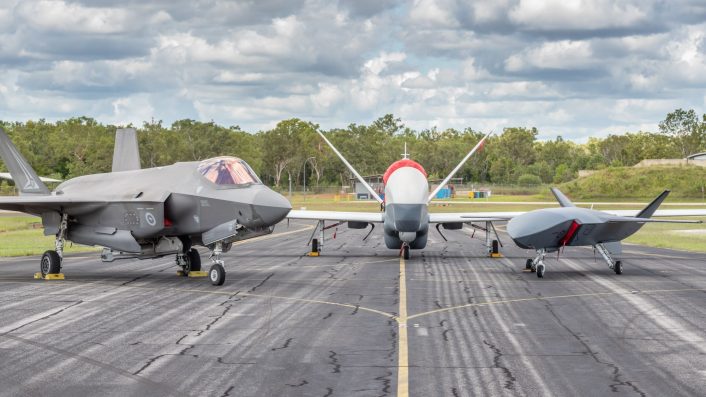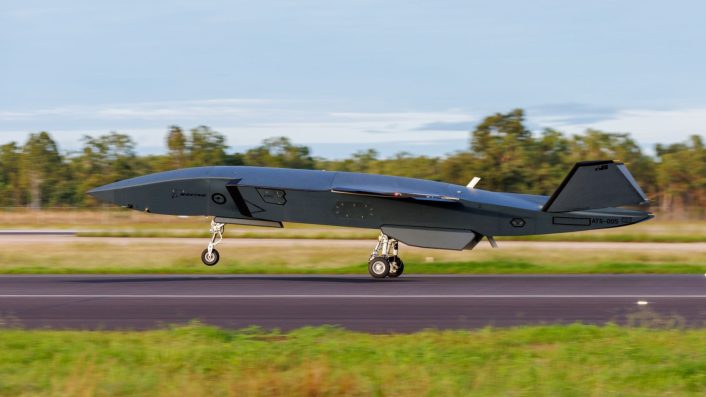The Collaborative Combat Aircraft operated for the first time outside of the Woomera Training Area during Exercise Carlsbad in April 2025 at RAAF Tindal, which hosts F-35A and MQ-4C units.
Early in April 2025, the Royal Australian Air Force (RAAF) tested the MQ-28A Ghost Bat Collaborative Combat Aircraft (CCA) for a week at RAAF Tindal in the Northern Territory, marking the first time it operated outside the Woomera Training Area in South Australia where it exclusively operated since the first flight. Boeing and the Australian Department of Defence first revealed the development on Jun. 20, with more info released on Jun. 25.
Called Exercise Carlsbad, the announcement of the trial campaign at the operational RAAF base comes after Boeing Defence Australia announced on Jun. 16, 2025 that an E-7A Wedgetail AEW&C aircraft controlled two Ghost Bats in a mission against a simulated target. It is unclear when this exercise took place, although we cannot exclude that the manned-unmanned teaming event might have happened during Exercise Carlsbad.
At the time, Boeing said that future events would also include the F/A-18F and F-35 fighters. As a matter of fact, RAAF Tindal hosts F-35s as well as MQ-4C Triton UAS.
The press release about April’s “first mission at a deployed location” explained that the exercise also tested how to deploy the MQ-28 in an unfamiliar environment. Because of this, the aircraft was transported to RAAF Tindal in a C-17 “within a seven day period” it conducted the first flight, said Boeing’s latest release.
Exercise Carlsbad Commander Wing Commander Phillip Parsons said in the DoD release that the C-17 Globemaster transported the “capability direct from the Australian International Air Show.” That show was held from Mar. 25 to Mar. 30, 2025, implying Exercise Carlsbad was held very early in the first week of April
Exercise Carlsbad’s successful completion “demonstrated that the MQ-28A can conduct operations from a location outside of the Woomera Training Area, South Australia, which to date has been the exclusive operating location for the MQ-28A,” added the press release.
Flight of the Ghost Bat! ✈️👻🦇
The MQ-28A Ghost Bat achieved first flight outside of Woomera Training area during Exercise Carlsbad.
Ghost Bat is the first military aircraft designed and built in Australia in more than 50 years. #YourADF pic.twitter.com/mO3Y0upyB6
— Defence Australia (@DefenceAust) June 21, 2025
Tested with F-35A and MQ-4C Triton?
Images released by both Boeing and the Department of Defence showed a Ghost Bat on the tarmac, with a Royal Australian Air Force (RAAF) F-35A taxing behind “after a sortie.” In the short minute-and-a-half video feature by Defence Australia, Wing Commander Philip Parsons said the MQ-28 team collaborated with the RAAF’s No. 17 Squadron, No. 9 Squadron and No. 75 Squadron at Tindal “to achieve what we need to do.” The last two squadrons home-based at RAAF Tindal operate the MQ-4C Triton ISR UAV and the F-35A Lightning II, respectively.
Another image showed the Ghost Bat, the Triton and the Lightning II parked at the end of the runway for an official photograph, representing the three aircraft which participated in Exercise Carlsbad.
We’ve completed our first flight at an operational Air Force base with the support of @AusAirForcetesting our ability to deploy and fly from unfamiliar environments.
📷 F-35A Lightning II taxis past MQ-28 at RAAF Base Tindal.
More: pic.twitter.com/qRjI7OcJXV
— Boeing Australia (@BoeingAustralia) June 25, 2025
This suggests the MQ-28A may have had some sort of interaction with the F-35A and the MQ-4C Triton. The RAAF’s concept envisions the employment of the MC-55A Peregrine, E-7A Wedgetail and multirole aircraft like the F-35A Lightning II and the E/A-18G Growler as a combined network of multirole strike and electromagnetic sensing aircraft.
Concept illustrations from Boeing have shown the Ghost Bat flying with the E-7A Wedgetail, beside the F-15EX and the EA-18G Growler. Boeing had previously said the AI-enabled Ghost Bat can “work as a smart team with existing military aircraft to complement and extend airborne missions.” It could also serve in an escort role for high-value support assets such as the E-7A or KC-30 aerial refueler.
The MQ-28A is meant to “to team with crewed platforms performing mission roles and responsibilities typical of fighter aircraft, complementing and extending airborne missions while increasing situational awareness and survivability,” the Australian Department of Defence release added.
Thus the official statements, images, the picture captions and the context of the exercise are short of an explicit confirmation that the Ghost Bat interacted with the F-35A and the MQ-4C in the air. What that interaction constituted remains unclear, but may have involved establishing elementary communication and data transfer protocols between the aircraft.

Exercise Carlsbad
Wg. Cdr. Philip Parsons said in the short video that they conducted a “bunch of ground events – engine runs, ground runs, some high-speed taxi trials on the airfield – just to confirm all our systems are in good working order.” Parsons, a remote systems pilot, was also the first RAAF and non-Boeing pilot to fly the aircraft from the ground control station on Jun. 13, 2024.
The MQ-28A Ghost Bat then “went flying, flew a circuit and are now back here [at RAAF Tindal],” Parsons added. The Ghost Bat is also seen raised on hydraulic jacks as its landing gear is being lowered during ground testing. Exercise Carlsbad figured the “fundamental inputs to capability” regarding “how to deploy, how to operate in a different location with the MQ-28 Ghost Bat,” Parsons added.
During Parsons’s first operation of the Ghost Bat mentioned above, Boeing Defence Australia’s MQ-28 global program director Glen Ferguson said that the unmanned aircraft teams with “piloted aircraft through an ‘operator-in-the-loop’ approach.” While it is AI-enabled and autonomous, Parsons, as the launch and recovery operator, would oversee its ground preparation, take-off and landing operations. This adds “another layer of safety, and Parsons’s training included observing and monitoring the aircraft as it executed commands to climb and descend, accelerate and decelerate, or navigate along waypoints.”


Operational location, unfamiliar environments
Boeing Defence Australia called Exercise Carlsbad at RAAF Base Tindal “a proof point for the autonomous aircraft’s ability to establish operations and deploy from […] unfamiliar environments.” Ferguson said in the release this proved its “utility […] across varying scenarios.”
“This deployment […] provides a strong foundation for future capability demonstrations including teaming with crewed RAAF assets. It was also an opportunity for us to execute some of the elements required to integrate MQ-28 into the force mix including interacting with multiple Defence organisations and units,” he added.
Defence Australia said Exercise Carlsbad’s “successful completion” is part of an effort to continue to “assess the MQ-28A Ghost Bat through systematic testing in both live and digital environments, and remains focused on demonstrating MQ-28A platform, payload and system capability in 2025.”
Boeing and the Royal Australian Air Force (RAAF) have, for the first time, deployed and operated the MQ-28 Ghost Bat collaborative combat aircraft from an operational Air Force base. #aviation #aerospace pic.twitter.com/GFdi65Na9z
— Australian Aviation (@ausaviation) June 26, 2025
The MQ-28A Ghost Bat in Exercise Carlsbad
Interestingly, the Ghost Bat seen in the video has a full dark-grey paint scheme, compared to the one with multiple orange parts seen so far on the Ghost Bats. Of the eight Block 1 Ghost Bats that have been reported to be produced, a maximum of four have been photographed with this paint scheme.
These parts on the Ghost Bat seen in the latest test are painted dark black. The one that flew for the first time in Feb. 2021 bore serial PRV-001 and sported a flight data probe (pitot tube) on the nose. The aircraft seen during the exercise, bearing the serial ATS-005, is not equipped with a data probe.
ATS might refer to the project’s original name, ‘Airpower Teaming System’. It is not clear whether this is a new production model in the Block 1 series, an unseen airframe that has not been photographed so far, or an existing build that has been repainted.
The heavily stealth-centric design has also been shown with three different nose sections in computerized illustrationswith one sporting what seems like a FLIR/IRST (Forward-Looking Infrared/Infrared Search and Track). Its 1.5 cubic meter nose can hold interchangeable ISR (Intelligence, Surveillance Reconnaissance), aerial radar surveillance and EW/ELINT payloads.
The DSR acknowledges the importance of the MQ-28A Ghost Bat to our air domain.
As the first military combat aircraft in 50 years to be designed, engineered & manufactured in 🇦🇺 #AusAirForce recognises how our #Stem professionals are enhancing Air Force capability.#scienceweek pic.twitter.com/3wsTrPeYtw
— Air Marshal Stephen Chappell (@CAF_Australia) August 16, 2023
Eight Block 1 Ghost Bats have been produced so far, while the Block 2 are expected to be ready by 2025. The eight active Block 1 MQ-28As have until now conducted 102 test flights. As The Aviationist reported in context of Saab providing equipment for Australia’s Ghost Bats, the Block 2s will be informed by results of the testing on the Block 1 aircraft.
Royal Australian Air Force begins training first pilots to operate MQ-28A Ghost Bat Loyal Wingman drones pic.twitter.com/qFj7U0Fymu
– Roses breasts (@RONI_Sont) August 26, 2024
While the Block 2 Ghost Bats will not have significant airframe changes, they would lose the dogtooth wing sported on the Block 1s. Other upgrades would involve maintenance-friendly internal components, and a new Global Positioning System (GPS)/Inertial Navigation System (INS).
Source link
[aviation news]
Share this content:


